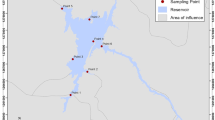Abstract
The Turkish freshwater lakes, Sapanca, Iznik and Taskisi (Calticak) have been enriched with nutrients from agriculture and domestic sources for many years. A major bloom of cyanobacteria (blue-green algae) in Lake Sapanca was recorded in May 1997, closely followed by a fish kill. Investigations were subsequently made on the cyanobacteria and water quality of the lakes, including analysis for cyanobacterial hepatotoxins (microcystins) in the filtered particulate fraction. Samples, taken from the beginning of May to end of August 1998, were analysed for microcystins by high–performance liquid chromatography with photodiode array detection (HPLC-PDA), protein phosphatase inhibition assay (PPIA) and an enzyme-linked immunosorbent assay (ELISA). No microcystins were detected in the water column in Lake Sapanca above 10 m, but toxins were found in filtered cyanobacterial samples from 20 m depth at a concentration of 3.65 μg l−1 microcystin–LR equivalents. Ninety percent of the microcystin pool detected in L. Sapanca was found between depths of 15 and 25 m. The principal microcystin detected by HPLC-PDA was similar to microcystin–RR. Two unidentified microcystin variants were found in Lake Taskisi surface samples at a concentration of 2.43 μg l−1 microcystin–LR equivalents in the filtered cyanobacterial cell fraction. Although 10 water samples (10 × 5 l) were taken from Lake Iznik (surface to 20 m, 5 m intervals), no microcystins were detected by HPLC-PDA (limit of detection 10 ng). The depth at which microcystins were detected in L. Sapanca coincided with the draw-off depth for the drinking water supply for the city of Sakarya
Similar content being viewed by others
References
Albay, M., 1996. The investigation of pollution levels from the point of view of biology of Lake Iznik. Doctorate Thesis, Istanbul University, Institute of Science, Istanbul. In Turkish.
An, J. & W. W. Carmichael, 1994. Use of a colorimetric protein phosphatase inhibition assay and enzyme linked immunosorbent assay for the study of microcystins and nodularins. Toxicon 32: 1495–1507
Aykulu, G., K. Dogan & S. Hasirci, 1999. A study on the phytoplankton communities of Lakes Taskisi and Poyrazlar (Adapazari, Turkey). Istanbul University, J. Aquat. Prod. Special Issue 157–184.
Bell, S. G. & G. A. Codd, 1994. Cyanobacterial toxins and human health. Rev. Med. Microbiol. 5: 256–264.
Budakoglu, M. & Y. Burkut, 1995. Trend surface and cluster analysis of Iznik Lake surface water. The Symposium on Mining Chemistry. 7–10 November, 1995, Istanbul, Turkey: 117–124.
Carmichael, W.W., 1992. Cyanobacteria secondary metabolites: the cyanotoxins. J. appl. Bacteriol. 72: 445–459.
Carmichael, W.W., 1994. The toxins of cyanobacteria. Sci. am. 270: 64–72.
Carmichael, W. W., S. M. F. O. Azevedo, J. S. An, R. J. R. Molica, E. M. Jochimsen, S. Lau, K. L. Rinehart, G. R. Shaw & G. K. Eaglesham, 2001. Human fatalities from cyanobacteria chemical and biological evidence for cyanotoxins. Envir. Health Persp. 109: 663–668.
Chorus, I. & J. Bartram, 1999. Toxic cyanobacteria in water. E. & FN. SPON, London. 416 pp.
Codd, G. A., 1995. Cyanobacterial toxins: occurrence, properties and biological significance. Wat. Sci. Technol. 32: 149–156.
Codd, G. A., 2000. Cyanobacterial toxins, the perception of water quality, and the prioritisation of eutrophication control. Ecol. Eng. 16: 51–60.
Feuillade, M., G. Pora-John & J. Feuillade, 1996. Toxic compounds to Artemia from blooms and isolates of the cyanobacterium Planktothrix rubescens. Arch. Hydrobiol. 138: 175–182.
Jochimsen, E. M., W. W. Carmichael, J. S. An., D. M. Cardo, S. T. Cookson, C. E. M. Holmes, de C. M. D. Antunes, D. A. de Melo Filo, T. M. Lyra, C. S. V. Barreto, S. M. F. O. Azevedo & W. R. Jarvis, 1998. Liver failure and death after exposure to microcystins at a haemodialysis center in Brazil. New Engl. J. Med. 338: 873–878.
Loizzo, A., N. Secchi, L. Volterra & A. Contu, 1998. Some features of a bloom of Oscillatoria rubescens D.C. registered in two Italian reservoirs. Water, Air Soil Pollut. 38: 263–271.
Lund, J. W. G., C. Kipling & E. D. Le Cren, 1958. The inverted microscope method of estimating algal numbers and the statistical basis of estimations by counting. Hydrobiologia 11: 143–170.
Metcalf, J. S., S. G. Bell & G. A. Codd, 2000. Production of novel polyclonal antibodies against the cyanobacterial toxin microcystin-LR and their application for the detection and quantification of microcystins and nodularins. Wat. Res. 34: 2761– 2769.
Neumann, U. & J. Weckeser, 1998. Elimination of microcystin peptide toxins from water by reverse osmosis. Envir. Toxicol. Wat. Qual. 13: 143–148.
Pflugmacher, S., C. Wiegand, K. A. Beattie, G. A. Codd & C. E. W. Steinberg, 1998. Uptake of the cyanobacterial hepatotoxin microcystin-LR by aquatic macrophytes. J. Appl. Bot. 72: 228– 232.
Pouria, S., A de. Andrade, J. Barbosa, R. L. Cavalcanti, V. T. S. Barreto, C. J. Ward, W. Preiser, G. K. Poon, G. H. Neild & G. A. Codd, 1998. Fatal microcystin intoxication in haemodialysis unit in Caruaru, Brazil. Lancet. 352: 21–26.
Rott, E., 1981. Some results from phytoplankton counting intercalibrations. Schweiz. Z. Hydrol. 43: 34–62.
Sivonen, K. & G. Jones, 1999. Cyanobacterial toxins. In Chorus, I., E. Bartram & F. N. Spon (eds), Toxic Cyanobacteria in Water London: 41–411.
Technicon Industrial Methods, 1977a. Nitrate and Nitrite in Water and Wastewater. No. 158–71 W/A.
Technicon Industrial Methods, 1977b. Phosphate Analysis in Water and Seawater. No. 253–280 E.
Vasconcelos, V. M., 1995. Uptake and depuration of the peptide toxin microcystin-LR in the mussel Mytilus galloprovinciallis. Aquat. Toxicol. 32: 227–237.
Ward, C. J., K. A. Beattie, E. Y. C. Lee & G. A. Codd, 1997. Colorimetric protein phosphatase inhibition assay of laboratory strains and natural blooms of cyanobacteria: comparisons with highperformance liquid chromatographic analysis for microcystins. FEMS Microbiol. Lett. 153: 465–473.
Author information
Authors and Affiliations
Rights and permissions
About this article
Cite this article
Albay, M., Akcaalan, R., Tufekci, H. et al. Depth profiles of cyanobacterial hepatotoxins (microcystins) in three Turkish freshwater lakes. Hydrobiologia 505, 89–95 (2003). https://doi.org/10.1023/B:HYDR.0000007297.29998.5f
Issue Date:
DOI: https://doi.org/10.1023/B:HYDR.0000007297.29998.5f




